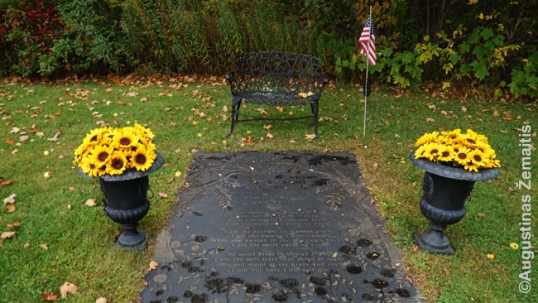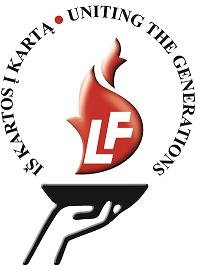Vermont
Vermont has few Lithuanians but it is there, in the town of Battleboro, where the famous Neringa Lithuanian camp stands.

Entance to Camp Neringa.
The camp has been established in 1970. Every summer it attracts many children, teenagers, and currently also adults from all over America to numerous Lithuanian vacation programs. Currently, art programs, culinary programs are also available. Some of the programs are meant for those who speak Lithuanian, others are for English-speakers, but all of them are Lithuania-related.

Camp Neringa houses.
As such, Camp Neringa has an especially Lithuanian ambiance. For example, the camp visitors have constructed a symbolic sculpture of an Iron Wolf and a replica of Gediminas castle. Gediminas castle (its sole surviving red-brick tower) is a symbol and the most famous building of Vilnius, the capital of Lithuania. Iron Wolf, on the other hand, is the mythological creature that has a firm place in Vilnius legends: according to those legends, grand duke Gediminas dreamt of an Iron Wolf and the wizard Lizdeika explained this dream as an order to Gediminas to build a new city (at those times somewhat synonymous with a castle) in that location. That city is what is now Vilnius.

Gediminas Castle and Iron Wolf in Neringa.
Moreover, the camp Neringa has a Lithuanian cross and a Lithuanian chapel-post (a.k.a. elevated shrine). These are UNESCO-inscribed traditional Lithuanian folk arts. The camp has been established by the Lithuanian nuns of Immaculate conception from Putnam, CT (the predecessor of this camp used to take place at their monastery) – this is another reason for its Christian decor.

Traditional Lithuanian chapel-post in camp Neringa.

A traditional Lithuanian cross in camp Neringa.
The key site in Neringa is its 1989 chapel which reminds the Lithuanian village church belfries in its forms. In 1989, these belfries were still largely inaccessible to the Lithuanian-Americans, they were a part of that long-lost far-away homeland. That‘s because Lithuania was occupied by the Soviet Union at the time. The stained-glass windows inside the chapel have been crafted by a famous Lithuanian designer of church interiors V. K. Jonynas.

Camp Neringa chapel, built in 1989. Inside, it houses the stations of the cross by the famous designer V. K. Jonynas, moved here from the closed Albany Lithuanian church
The camp that became "Neringa" was founded in 1958 as a girls-only camp led by the Lithuanian Sisters of Immaculate Conception in their motherhouse in Putnam, CT. In 1976, the current "Neringa" campsite was acquired and developed ever since. In "Neringa", the girls-only camp from Putnam was combined with a boys-only camp that used to take place in the Lithuanian Franciscan Fathers convent at Kennebunkport, ME, thus becoming a both-genders camp. As the Sisters of Immaculate conception grew scarcer in numbers, "Neringa" was sold to a secular Lithuanian non-profit, mostly led by "Neringa" alumni. In total, 120 people may camp in "Neringa" at a single time.
The only other Lithuanian heritage site in Vermont is the grave of Charles Bronson (Karolis Bučinskis) who was the most famous Lithuanian Hollywood actor. It is located in West Windsor.

Charles Bronson grave in Vermont
The map
All the Lithuanian locations, described in this article, are marked on this interactive map, made by our "Destination Lithuanian America" expedition (click the link):
Interactive map of New Hampshire and Vermont Lithuanian sites






August 14th, 2019 - 17:14
Does camp Neringa plan some event for the 30th anniversary of Unity Wave of the Baltic Way? Would be nice to know that Vermont is a part of big event in Lithuania in August 23.